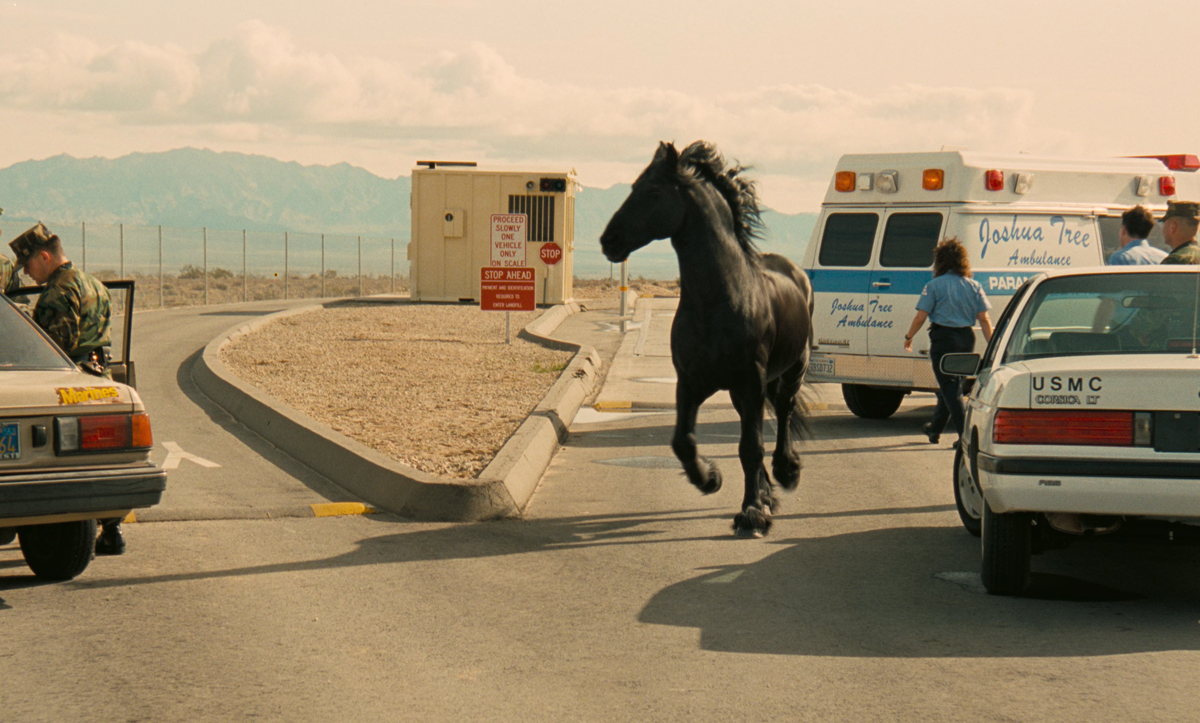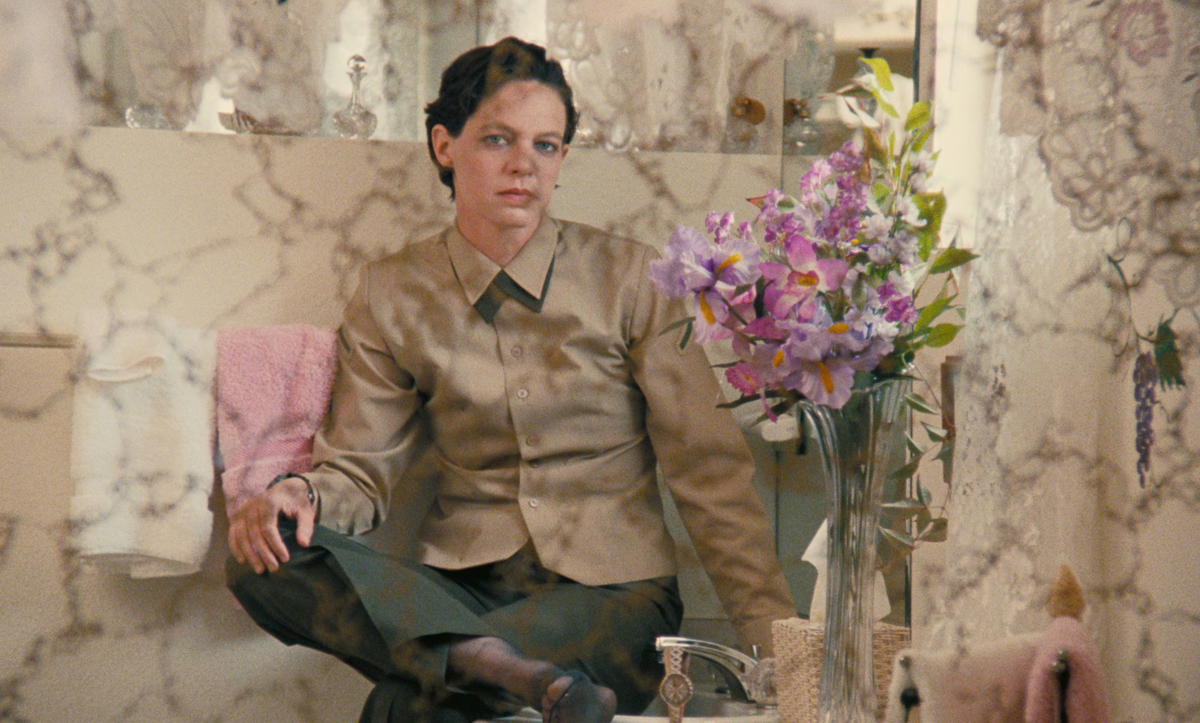 Erika Balsom
Erika Balsom
Women who drift, die, kill, and dream: the beguiling work of
a feminist filmmaker.

Tinka Menkes as Firdaus in Queen of Diamonds. Courtesy Arbelos Films.
“Cinema is Sorcery: The Films of Nina Menkes,” Brooklyn Academy of Music, 30 Lafayette Avenue, Brooklyn, through March 10, 2022
• • •
The Brooklyn Academy of Music’s retrospective of six fiction films by Nina Menkes, “Cinema is Sorcery,” is occasioned by the welcome appearance of restorations of several of the director’s key works from the 1980s and 1990s. It also roughly coincides with the first screenings of her new documentary, Brainwashed: Sex-Camera-Power, which premiered at Sundance in January and played at the Berlinale in February. Originating as a lecture concerning the representation of women in dominant cinema, Brainwashed features Menkes onstage with a laser pointer, speeding her way through dozens of clips that purportedly exemplify that most reviled and oversimplified of filmic phenomena, the male gaze. Via a triangular diagram, she dubiously asserts a direct link between this visual language and the prevalence of employment discrimination and sexual assault. Historical contextualization is not a priority. Brainwashed is prescriptive, puritanical, reductive—exactly what Menkes’s earlier films, which feature prominently within it as good objects, are not. Whereas her latest project indulges the banal clarity of the list and the numb rigidity of the rule, her earlier oeuvre takes aim at that very way of knowing. Driven by the murk of intuition, these essential works of American independent cinema are replete with ambiguities that Brainwashed nowhere allows.

Still from The Bloody Child. Courtesy Arbelos Films.
On the desert highway that serves as the primary setting of Menkes’s third feature, The Bloody Child (1996), three road signs appear again and again, halting all forward movement: stop, do not enter, wait here for the green light. But what if the green light never comes? In this film, inspired by the true story of a Gulf War veteran in Twentynine Palms who killed his pregnant wife and was found by fellow marines while digging her grave, a woman’s corpse brings progression to a standstill. Dispensing with chronology and embracing the hallucinatory potential of repetition, Menkes cycles through a series of moments surrounding an unrepresented death. Out of what feels like a frozen present, she carves a crystalline hell within which to anatomize the murderous boredom and routine aggression of both heterosexuality and the military. A girlish, disembodied voice floats across the film, laughing and babbling at the threshold of intelligibility, borrowing words from the Wayward Sisters of Macbeth and the Evil Queen of Snow White; the credits name her as the murdered wife, whose mutilated body is sprawled in the backseat of a car at the roadside. Grainy 16mm images shot in Egypt and Sudan intrude on the crisp naturalism of the 35mm Californian vistas, offering lyrical glimpses of inassimilable otherness. Within this strange and transfixing construction, Menkes’s insistent return to the traffic signs seems like a declaration of form as well as a warning to the viewer: give up on all assumptions about what a narrative film does, be prepared to tarry, know that there is nowhere to go but deep down into the film’s vertical trap.

Marina Shoif as Lulu in Phantom Love. Courtesy Arbelos Films.
To be able to pin an interpretation like this, even tentatively, on one of Menkes’s images is rare. From the mid-length The Great Sadness of Zohara (1983) on, her fiction films are oneiric force fields in which sense and story wither in the face of sensation. Sometimes they advance legible symbolism, as in the multiple recurring shots of Lulu (Marina Shoif), the main character of Phantom Love (2007), stepping over a giant snake in a hotel corridor. But more often and more seductively, they push up against what Freud called the “navel of the dream”: “the spot where it reaches down into the unknown,” the point at which analysis falters. What could it mean, after all, to find a ring hidden inside a whole cooked fish, as the protagonists of both Queen of Diamonds (1991) and Dissolution (2010) do? For elephants to appear out of nowhere and sway in the night or for a lone palm tree to go up in flames? The African sequences of The Bloody Child resist being deciphered in relation to the Mojave murder in all but the most speculative ways.

Still from Queen of Diamonds. Courtesy Arbelos Films.
Menkes, who acted as her own cinematographer until Phantom Love, builds these films from striking visions that overflow the tales of sexuality and violence that house them, searing the eye and mind with mysterious opacity. The retrospective’s title, “Cinema is Sorcery,” takes up a metaphor that the director has often used to describe her work, and with good reason: inhabiting the feature format yet deeply indebted to the tradition of experimental filmmaking, her films are conjurations that open surreal intervals in which women drift, die, kill, and dream. Like witches, these characters tend to possess a disruptive, feminine intensity; like witches, too, they are at odds with the world around them, subject to marginalization and punishment. The feminist commitment that fuels this approach sits at a vast distance from any affirmation of empowerment or didacticism. It entails upending convention to picture the brutality, wonder, despair, bravery, and exhaustion that everywhere mark women’s lives but which rarely find representation onscreen—at least not with the incantatory power that Menkes brings to them.

Marina Shoif as Lulu in Phantom Love. Courtesy Arbelos Films.
From the Super 8 short A Soft Warrior (1981, not included in the retrospective) up to and including The Bloody Child, each of these films stars the same formidable performer, the director’s sister, Tinka Menkes. In Magdalena Viraga (1986)—another claustrophobic treatment of gendered violence, rendered nonchronologically—she is a sex worker accused of murder, the same deed committed by the protagonist of Nawal El Saadawi’s Woman at Point Zero, the 1977 novel from which the name of the blackjack croupier she incarnates in Queen of Diamonds is lifted. In The Bloody Child, she has a double role, embodying the schism at the film’s heart: in California, she is a marine sergeant, while in the African sequences, she is a languid cipher who never utters a word, reminiscent of her character in Zohara. Tinka is the center of gravity of these films, responsible in no small part for their disturbing enchantment.

Tinka Menkes in The Bloody Child. Courtesy Arbelos Films.
Something feels painfully missing from Phantom Love and Dissolution, two later works in which Tinka does not appear, ceding her place to more actorly actors who simply do not possess the same obstinate presence, the same intimate complicity with their director, as she. Forlorn and pale, fierce and withdrawn, she is the lodestone of a sororal cinema full of bad feelings, perplexity, and magic. The marketing for Brainwashed proposes the hashtag #breakthespell. The rejoinder comes too easily: Nina Menkes, especially when collaborating with her sister, is much better at casting them.
Erika Balsom is a Reader in Film Studies at King’s College London. Her book on James Benning’s TEN SKIES (2004) is now available from Fireflies Press as part of its Decadent Editions series.